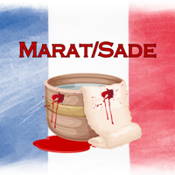
Overview
Synopsis
Set in the Asylum of Charenton, Peter Weiss's play shows inmates of the mental facility re-enacting the last days of political agitator Jean Paul Marat's life fifteen years earlier. The play within the play has been written and directed by the Marquis de Sade, a fellow inmate at the asylum. In the lead up to Marat’s brutal murder in his bathtub at the hands of Charlotte Corday, Sade takes his audience on an examination of power, social hierarchy, suffering, and human nature. As such, Sade not only runs the play but uses it as a means to instruct society at large. Peter Brooks’ notorious staging of the play in 1964 sent shockwaves through British theatre and Marat/Sade remains as innovative, controversial, and thought-provoking today.
Show Information
- Book
- Peter Weiss
- Category
- Play
- Age Guidance
- Mature Audiences (M)
- Number of Acts
- 2
- First Produced
- 1963
- Genres
- Historical/Biographical, Drama
- Settings
- Period, Unit/Single Set
- Time & Place
- Charenton Asylum, France, 1808
- Cast Size
- large
- Licensor
- Dramatic Publishing Co.
- Ideal For
- College/University, Mature Audiences, Professional Theatre, Regional Theatre, Mostly Male Cast, Includes Mature Adult, Adult, Young Adult, Late Teen Characters, Large Cast
Context
The full name of the play is The Persecution and Assassination of Jean-Paul Marat as Performed by the Inmates of the Asylum of Charenton Under the Direction of the Marquis de Sade but it is usually shortened to Marat/Sade. It was first published in German in 1963 under its original German translation title. The following year, the play was translated by Geoffrey Skelton (with lyric adaptation by Adrian Mitchell) and staged by the Royal Shakespeare Company under the leadership of the
to read the context for Marat/Sade and to unlock other amazing theatre resources!Plot
Act One
In the bath hall of an asylum at Charenton, the Marquis de Sade is busy making last minute preparations for a play he has written. The parts will be played by the inmates and the audience consists of Coulmier, the director of the asylum, his family, and other members of the French aristocracy. Coulmier introduces the play, proud of the modern therapies he has introduced at Charenton, including linking education and art.
The play begins with the Herald pointing out the main
to read the plot for Marat/Sade and to unlock other amazing theatre resources!Characters
| Name | Part Size | Gender | Vocal Part |
|---|---|---|---|
|
Lead |
Male |
Non-singer |
|
|
Lead |
Male |
Non-singer |
|
|
Supporting |
Female |
Non-singer |
|
|
Supporting |
Male |
Non-singer |
|
|
Supporting |
Male |
Non-singer |
|
|
Supporting |
Male |
Non-singer |
|
|
Supporting |
Either Gender |
Non-singer |
|
|
Featured |
Female |
Non-singer |
|
|
Featured |
Either Gender |
Soprano, Tenor, Baritone, Bass |
|
|
Featured |
Male |
Silent |
|
|
Featured |
Male |
Silent |
|
|
Ensemble |
Either Gender |
Non-singer |
|
|
Ensemble |
Either Gender |
Non-singer |
|
|
Ensemble |
Female |
Silent |
|
|
Ensemble |
Female |
Silent |
Songs
A song with an asterisk (*) before the title indicates a dance number; a character listed in a song with an asterisk (*) by the character's name indicates that the character exclusively serves as a dancer in this song, which is sung by other characters.
Monologues
Scenes
Key Terms
Theatre that is inspired by the work of Bertolt Brecht, especially in its use of unconventional storytelling, political message, and experimentalism.
The political upheaval that began in 1789 and ended with the overthrow of the Bourbon monarchy in France in 1799. It marked a watershed moment in European history.
Telling a story, often accompanying or guiding the central action of the play.
A form of experimental theatre that was proposed by the French actor and theorist Antonin Artaud. It uses sensory details such as expressions, gestures, sounds, and lights to shock audiences.
Videos
Quizzes
Themes, Symbols & Motifs
Sorry! We do not currently have learning modules for this guide.
Quote Analysis
Sorry! We do not currently have learning modules for this guide.
